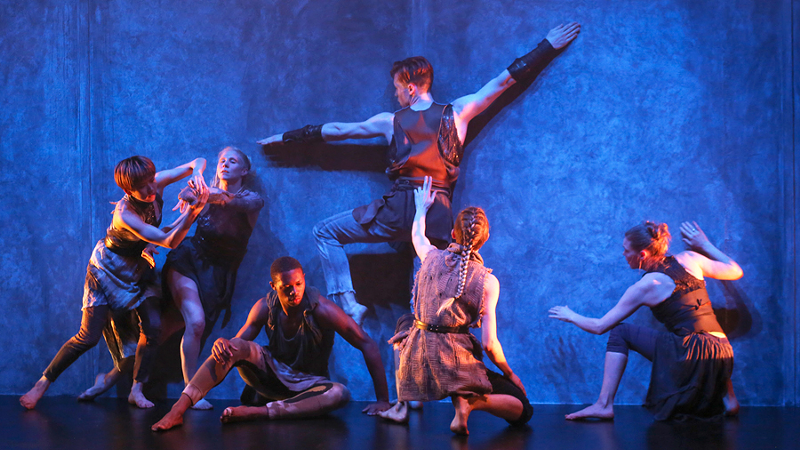“It’s like we’re a little microcosm of the larger world,” she says by phone from her New York home. “We’re the ones there to serve or to bind together, to find strength, to persevere.”
On Friday and Saturday, Mills and her five dancers come to the Aronoff Center’s Jarson-Kaplan Theater to perform her original and daring dance-theater production, After the Feast, in a presentation sponsored by the Contemporary Dance Theater. It premiered earlier this year at New York’s experimental La MaMa Theatre.
Before that premiere, Mills described on Kickstarter her vision for After the Feast, which features contributions from dedicated collaborators, including an original score by Jonathan Melville Pratt: “After the Feast turns an unflinching eye toward a possible future, theatrically creating the next phase of human existence when everything known has crumbled or become depleted, inviting catastrophe. Through a fusion of movement, music and visuals, the piece questions what remains in a post-apocalyptic world and explores what shape new communities might take.”
Mills’ excitement is tangible as she discusses the pending performance of what she considers to be her pièce de résistance to date.
“The idea behind After the Feast is to think of the feast as some kind of bounty, and then ‘after the feast’ as some kind of depletion,” she says. “(It’s) thinking about — hypothetically — some kind of disaster, whether it be natural or manmade, that this community of dancers has to navigate, cope and struggle with to try to overcome.”
For Mills, After the Feast was an exercise that came naturally after living through the ordeal of 2012’s Hurricane Sandy, even though the production isn’t specifically about that.
“It really made us think about how you just don’t know what might be tomorrow, both in terms of how the environment might change and how things can change in the world,” she says. “We were also thinking about not only natural disasters but all the strife and war in the world, and how it really changes the landscape for everybody in tangible ways.”
These words feel especially timely after the undeniable strife America has just endured this election season, as well as the friction likely still to come. Still, it was the hurricane that made Mills and her dance company ponder their most basic needs and instincts in the wake of a crisis.
“What do we have? What remains?” she says. “A lot of our investigation made us realize that it’s community and the support we can give to each other.”
That positive note plays out in the dancing, too, although it’s less prominent than the uncomfortable notion that something crucial is in upheaval. “There’s a dark tone to the piece, but there’s hope within it,” Mills says. “In times of distress or some large seismic shift or disaster, how can we cope within a difficult situation?”
The research and collaboration that her company was able to delve into makes the entire production feel cohesive. “We played and did research on the past, thinking about our current life and reality as well as also looking back,” Mills says. “There are influences from medieval times — we went way back!”
At 46 years old, Mills has created more than 20 works for her dance company capitalizing on her love of athletic, risk-taking movement and visceral partnering. “I like to be upside-down,” she says.
Dance became a part of her life when she was just 4 years old; she studied tap, Jazz, ballet and, notably, gymnastics, through high school. At the University of Oregon, she received a bachelor’s degree in dance; at Ohio State University, she received a master’s in choreography.
The creation of After the Feast took Mills three years to complete. There were interruptions — commissions from other companies, smaller pieces to perform, personal life and all the other things that can stand in the way of a passion project. But the end result is something completely of Mills’ own creation. It has her signature dance moves, centered on strength and partnering.
Mills uses what she calls “contact improvisation” to translate her concepts into movements. “I’m interested in all the different ways dancers can partner together,” she says. “How men can lift men and women can lift women and women can lift men. I love to find three-dimensionality in space and defy gravity. But… as a choreographer, I’m always trying to say something about the human relationships, or a relationship within a community.
“In my company, there’s diversity in every way, not just ethnically but also in their backgrounds, movement-wise,” Mills says. “So the partnering is also a way to get at the human, because of the way humans react to each other, touch each other, bear and share weight with each other. All of that really brings out people’s personalities.”
For the Cincinnati production, visual designer Dennis O’Leary’s full set couldn’t be transported to the performance location. “It’s like a massive wall that harks a bit to a castle wall or a stone wall, and then tattered curtains are hung from the top of the stage space,” Mills explains. But she believes she’s found an effective substitute. “Hopefully, having a haze machine in Cincinnati will create sort of an altered reality in the space,” she says.
Despite the imagined future dystopia Mills and her dancers wish to create, her message is more than real.
“I’m not so interested in creating something abstract,” Mills says. “I’m interested in saying something about who we are today and taking a look at human frailty and vulnerability and strength within humans.”
Contemporary Dance Theater presents AFTER THE FEAST Friday and Saturday at the Aronoff Center for the Arts. Tickets and more info: cincinnatiarts.org.


